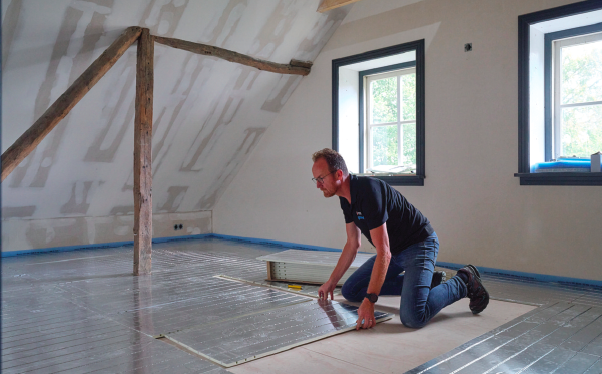
Underfloor heating systems are an ideal solution to help housebuilders and developers to meet low carbon heating requirements. Here, James griffiths Head of projects at gF building Flow Solutions (formerly uponor), outlines the issues to consider to ensure the right specification.
Over the last decade, the energy efficiency requirements for new homes have tightened significantly in an effort to cut the UK’s carbon emissions. The current version of Part L of the Building Regulations in England and Wales, introduced in June 2022, includes a substantially higher standard for new homes and requires a maximum heating flow temperature of 55ºC. Similarly in Scotland, the compliance guidance for Section 6 of the Building Standards states a maximum temperature of 50ºC. These standards are set to be tightened further with the introduction of the Future Homes Standard. Based on current proposals, this will eliminate the use of gas boilers in favour of low carbon heat sources, such as heat pumps and solar thermal systems.
Due to the lower flow temperatures at which heat pumps operate, it is essential to ensure that the system is designed correctly and that it meets the heating requirements of the property. This includes ensuring that the chosen heat emitters are sized correctly. When using traditional radiators, the sizes may need to increase significantly to accommodate the lower temperature. This is often not ideal as it limits the useable space within a room and is undesirable from an aesthetic perspective.
In contrast, the far larger surface area of hydronic UFH systems makes it ideal for lower flow temperatures. The delivery of heat over the entire floor area also lowers the amount of energy required to heat the space. When specifying a UFH system, there are key factors that must be considered to ensure the chosen option is efficient, effective and fit for purpose.
Hydronic or electric UFH
There are broadly two types of underfloor heating. Hydronic, which is a direct alternative to traditional radiators with hot water circulated through pipes, and electric UFH, which operates using heating cables or mats. On the face of it, electric might seem like an ideal solution given the push towards the electrification of heating. Especially if solar photovoltaic (PV) panels and storage batteries are fitted, providing low cost, renewable energy. Electric UFH is also generally lower cost and simpler to install. However, it is not suitable for all applications as it is less energy efficient, especially for large areas. Also, using electric UFH across sizeable areas within a property will place a high demand on the electrical system, which may not have the capacity. As such, electric UFH is generally most suited to smaller areas, such as bathrooms.
Thermal mass
Underfloor heating is most effective when there is sufficient thermal mass in the floor to absorb, store and release heat. Most often this mass is provided by the screed in which the pipes are laid. A sufficient level of thermal mass will help to minimise the energy required to achieve and maintain the target room temperature. An example of an effective floor construction for UF would be 65mm of screed laid over 65mm of floor insulation to minimise heat loss, ideally on a concrete subfloor. A very lowprofile system maximises the thickness of insulation that can be installed. For example, the Uponor Minitec underfloor system increases the floor height by just 15mm but still offers significant thermal mass as a screed-based product.
Tailored to the heat source
While there is a 50ºC or 55ºC maximum flow temperature set by the regulations, heat pumps and other low carbon sources may operate at an even lower temperature. If this is significantly below the permitted maximum, for example 40ºC, it may be that the UFH installation needs to be configured differently to achieve the required performance effectively. Leading UFH manufacturers will have the knowledge to provide support with this and can often recommend design solutions. This may be reducing the pipe pitches – the distance between the heating pipes – to deliver a higher output and make the system more reactive than it would have been with a standard layout.
Flooring materials
A further important factor to consider is the floor covering. There are a wide range of materials that work well with UFH, including tile, stone, vinyl and laminate flooring. Wooden flooring can be used, but a maximum thickness of 25mm is recommended to enable effective heat transfer. Similarly carpet, which is a popular choice, can be used with UFH but the product specification must be evaluated carefully. This is because if the carpet and underlay provide too much insulation, it will prevent the UFH from transferring the heat efficiently into the room. It is recommended that the combined insulation of the carpet and underlay is no more than 1.5 Tog.
Calculating this is not always simple so the best approach may be to choose from the products that the flooring manufacturers have classified as ‘suitable for underfloor heating’. Underfloor heating systems provide an ideal solution to ensure the required heating performance is achieved with low carbon and renewable heating sources, which are set to become mandatory in the coming years. Seeking technical support from leading manufacturers can help streamline and optimise the design and installation, especially where non-standard solutions are required.









